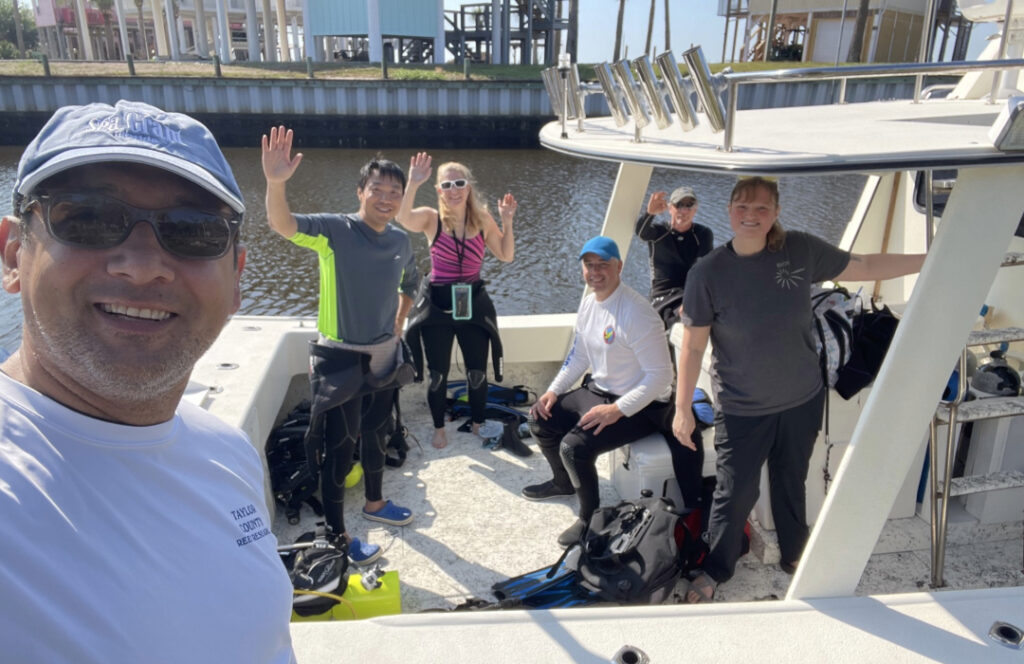Florida Sea Grant’s Artificial Reef Legacy is a 3-part series that explores the rich history of artificial reefs in Florida and highlights Florida Sea Grant’s longstanding support through science, monitoring, outreach, and education. In this installment, Taylor County FSG UF/IFAS Extension Agent, Victor Blanco, shares the human connections to artificial reefs, including Florida Sea Grant’s citizen science artificial reef monitoring program.
An underwater museum might sound far-fetched, but artificial reefs are relics from the past that symbolize both natural and human history. They act as artifacts, incorporating materials once used in buildings and infrastructure; they serve as historical markers, indicating dynamic marine conditions; and they commemorate individuals who have made lasting contributions in communities where reefs are placed.
Off the coast of Flagler County, 109 reef balls constructed by high school students from Mandarin High School in Jacksonville, were deployed into the sea, creating valuable marine habitat and recreational opportunities for local fishers and divers. The reef was named in honor of Joe Halusky, a longtime Florida Sea Grant Extension Program educator who played a vital role in the county’s marine efforts. Halusky’s early work in reef monitoring helped shape the protocols now used by the Florida Fish and Wildlife Conservation Commission (FWC), which requires monitoring as part of its artificial reef funding guidelines.
Monitoring efforts began with Joe Hulusky, Florida Sea Grant Extension Program educator, whose work laid the foundation in developing monitoring protocols for the Florida Fish and Wildlife Conservation Commission (FWC), which now requires monitoring as part of their funding guidelines.
Blanco with artificial reef monitoring divers. Image by Victor Blanco, Florida Sea Grant UF/IFAS Extension.
“Many of the methodologies used by local groups today were influenced by the work of Hulusky, who trained volunteer divers and worked closely with scientists involved in the scientific diver program. This initiative is considered one of the early examples of citizen science in the field,” says Dr. Lindberg.
The torch has now been passed to Florida Sea Grant Taylor County Extension Agent Victor Blanco, who leads monitoring programs in collaboration with the Florida Fish and Wildlife Conservation Commission (FWC) and leads the bidding committee with Taylor county members to assess contractor bids and reef options suitable for the county needs. Blanco oversees inspections, logistics, and material deployment, including pre-deployment surveys and post-deployment checks. He reports to the Florida Fish and Wildlife Conservation and county commissioners.
Blanco has played a key role in helping Taylor County establish a permanent, volunteer-based monitoring system for two artificial reef deployments that make up the 847-acre Buckeye Reef. The Buckeye Reef Program benefits from citizen science training, which formalizes the monitoring and enhancement of artificial reef habitat off Taylor County. Blanco has also introduced a new component to the monitoring and artificial reef initiative, with a focus on recreation.
“When I started the program in 2018, the goal was to build a community of divers —where they count fish, assess reef materials, and report data. Through the Citizen Science Program, we’ve enabled divers to visit these reef sites & see for themselves how rewarding it is to dive there,” says Blanco.
